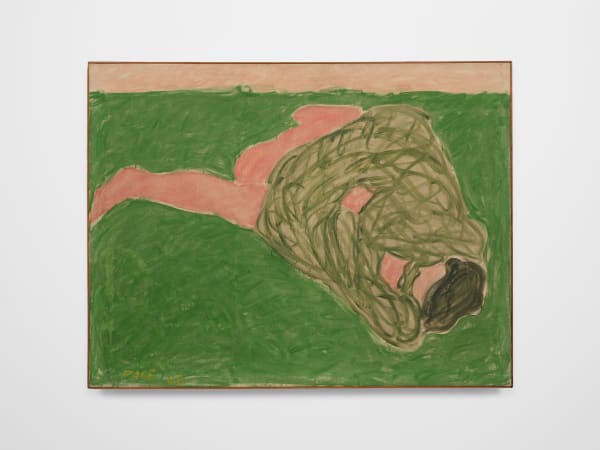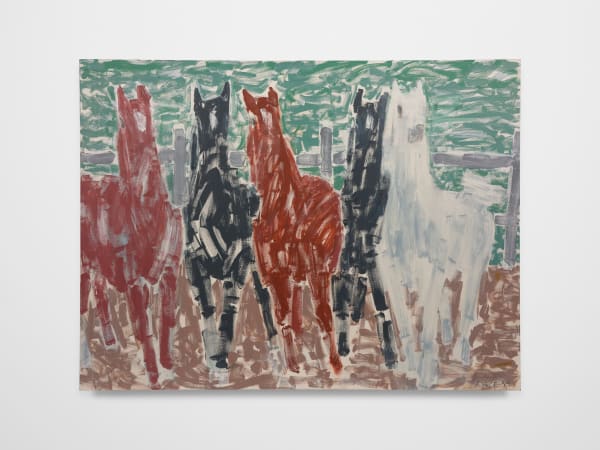-

-
Altman Siegel is thrilled to present Stephen Pace’s (b. Charleston, Missouri 1918, d. New Harmony, Indiana 2010) first exhibition on the West Coast since 1968. Black Horse/Brown Horse comprises a selection of paintings from one of Stephen Pace’s favorite subjects: horses. From the artist’s figurative period, these works recall memories of growing up and working on a farm in rural Indiana and Missouri. His depictions of horses go beyond their physical form, suggesting freedom, spirit, and power, and have been said to represent his close relationship with his three brothers. Pace imbues his humble scenes of bucolic life with intense, lively brushwork and vivid blocks of color. The sense of ease and simplicity these works evoke is rooted in abstract expressionism and minimalism, or as art historian Martica Sawin defined it: "Minimal Figuration."
-

-
Early champions of Pace’s work include Gertrude Stein, Frank O’Hara, Hans Hoffman, Willem and Elaine de Kooning, Jackson Pollock, and Milton Avery. A lifelong drawer - Pace caught the eye of Gertrude Stein while he was sketching near the edge of the Seine while stationed in Paris during WWII. She leaned over his shoulder and invited him to her home and the studios of some friends: Picasso and Braque. After the war, Pace enrolled at the Instituto Allende in San Miguel Allende, Mexico, on the G.I. bill. There, he met Milton Avery, who was traveling through Mexico with his family. They developed a long and enduring friendship. Along with Mark Rothko, Pace was one of only two speakers at Avery’s funeral.
-
-

-
-

-
-
In 1947, Pace moved to New York and began studying at the Art Students League, where he engaged in vigorous debates with Franz Kline, Mark Rothko, Barnett Newman, and Adolph Gottlieb. Pace returned to France two years later as a newlywed with his wife, Palmina. In Paris, he shared a studio with other American expats, Sam Francis, and Frank Lobdell. When Pace returned to New York, he enrolled in Hans Hofmann’s school. Hofmann was immediately impressed with him and often visited Pace’s studio to critique his work outside of class. In a 1959 Look Magazine interview, Hofmann identified Pace as one of his star pupils.
-

-
-

-
From 1953 to 1961, Pace achieved remarkable success as a leading second-generation New York Abstract Expressionist. He was included in significant exhibitions at the Cleveland Museum of Art, The Whitney Museum of American Art, and the Stable Gallery in New York. But in 1962, he made a defining change in his practice. He began moving away from abstraction back towards representation. Inspired by frequent trips to Maine, Pace adopted a singular language in painting that rendered still lives and portraits with the same vigor and bold color that characterized his abstract work. Pace would continue to work in this style for the next fifty years.
-
-
-

-
-
Stephen Pace’s career, a testament to his talent and dedication, spanned over seven decades with major exhibitions at institutions including the Museum of Modern Art (traveling exhibition), the Whitney Museum of American Art, New York, and the Art Institute in Chicago, Chicago. His work is included in over 50 museum collections around the world including American University, Washington, DC; Blanton Museum of Art, U of Texas, Austin; Museum of Fine Arts, Boston; UC Berkeley Art Museum and Pacific Film Archive, Berkeley, CA; Brown University, Providence, Rhode Island; Columbus Museum of Art, Ohio; Denver Art Museum, Colorado; Des Moines Art Center, Iowa; Hirshhorn Museum and Sculpture Garden, Smithsonian Institution, Washington, DC; Smithsonian American Art Museum, Washington, DC; Metropolitan Museum of Art, New York, NY; Whitney Museum of American Art, New York, NY; Yale University Art Gallery, New Haven, Connecticut; and Walker Art Center, Minneapolis, Minnesota.Thank you to The Stephen and Palmina Pace Foundation and Berry Campbell Gallery for supporting this project.














